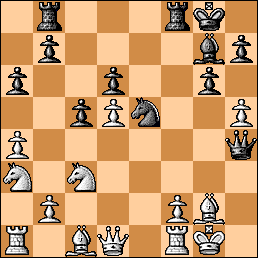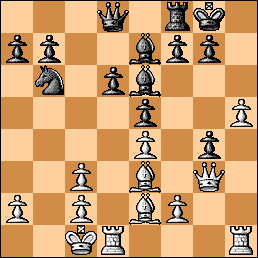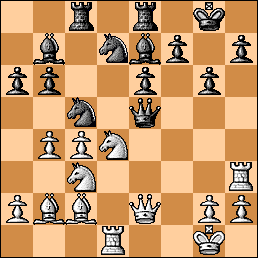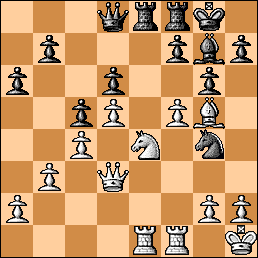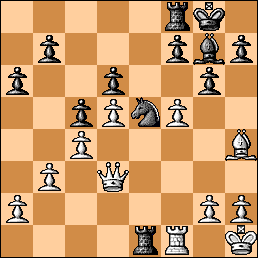Modern Benoni Debate
In the US Chess League, two Amanovs recently played one another. They have the same last name, but are not related. Mesgen playing white is from Turkmenistan and Zhanibek playing black is from Kazakhstan.
From the Chicago Blaze team’s blog, this entry by the winner, Chicago’s GM Mesgen Amanov. He defeated IM Zhanibek Amanov (LA). My comments in purple.
See this Stuff on an iPhone or iPad
My expanded comments are part of an iPhone/iPad app called “Chess U”. It’s available from iTunes.
Chess U is a free publishing platform and the Amanov battle is part of the “USCL 2011 – Volume 1″ course. This app also contains courses by guest authors such as Levon Altounian and Marcel Martinez.
M. Amanov (CHC) – Z. Amanov (LA) USCL 2011 notes by M Amanov
1. d4 Nf6 2. c4 c5 3. d5 e6 4. Nc3 exd5 5. cxd5 d6 6. g3 I like Bishop fianchetto against Benoni
On the other hand the g2-g3 move is not one most aggressive lines; white has also e4, Bd3, Nf3, h3 (central strategy) which theory likes although GM Gashimov has upheld the black side a few times.
g6 7. Bg2 Bg7 8. Nf3 O-O 9. O-O
Here we reached a tabiya of Benoni with a bishop fianchetto. Black has 3 options here:
a6
[9… Nbd7 ;9… Re8 ]
It’s funny that Mesgen does not mention the weak 9… Na6? played by no less than ex-World Champ GM Mikhail Tal vs GM Korchnoi. Korchnoi was rightfully critical of the move in his Best Games with White Volume. Korchnoi rolled over Tal in a rather one-sided rout, but 9… Na6 still deserves a place in the list as the fourth move.
10. a4 Nbd7
[10… Re8 ]
11. Nd2 This position remind me a pleasant moment in my life when GM N. De Firmian played: Rb8?
Re8 [11… Rb8? 12. Nc4 Nb6?? Simply enough mistake, my opponent forgot to play Re8, let’s see what could happen if you do forget. 13. Nxd6! After this move game is over, due 13…Qxd6 14. Bf4 and the absence of Re8 doesn’t give black chance to block diagonal. But this is another story. Ouch ]
12. h3 Rb8 13. Nc4 Ne5 This is what is considered the main line. Another option is Nb6 which leads to an absolutely different position where both sides playing on the queen side, black is preparing b5 and white is preventing it, if white knows what they are going they ended up in a better position. I recommend the “The Grandmaster Repertoire 1. d4 Volume 2” book by GM Boris Avrukh to see other variations.
14. Na3
This opening is a classic battle of chess ideas. White moves his knight far aside in order to drive black’s knight back and then reoccupy the center with his knight. The only question becomes, can black do anything with this gain of time before white realizes his plan and achieves total strategic domination?
14… Nh5 15. e4 f5 This variation leads to a temporary piece sacrifice.
The move f7-f5 is not necessary as black has non-sacrificial alternatives but a good choice at the USCL time control.
16. exf5 Bxf5 17. g4 Bxg4 18. hxg4 Qh4 19. gxh5 Now black sacrificed already 2 pieces, but soon white will be the one who will sacrifice something and black will remain balanced material
Rf8
20. h6! This move is known and without it white would be simply lost
This is an interesting moment. White is up two minor pieces and has the option here of 20. Bg5!? Qxg5 21. Ne4 Qh4 with further complications. I am not sure if white is lost here. However, 20. h6!? may be the best move, but don’t rule out 20. Bg5 just yet until we check it further. I’ll leave this placeholder to remind us to check 20. Bg5 more.
20… Bh8 21. Ne4 We have followed a main line of the Benoni and only here in afore-mentioned book Avrukh volume 2, author recommends Nc4 with a little trap 21…Nxc4? 22.Qd3! White’s Queen transfers to h3 and kills Black’s attack. I could do that but was pretty sure my opponent would play the same move and position simply transposes to the main line.
Ng4 22. Qxg4 There is no other way of stopping checkmate; white has to give up the Queen.
Qxg4 23. Nc4 This moment is the first point when my opponent decided to take a serious thought, but I was sure he knows the position. The only question I had was “Did he analyze this position very deep over the board with a book say another 10-15 moves or he just looked at another 3-4 moves and checked with computer” As I knew computer gives advantage to black by -0.54 Houdini. Silicon brain does not understand this position. It is well known that engines are bad with a material imbalance like here with the Queen for 3 minor pieces.
There’s another factor here: in the fast USCL time control, an active queen can wreak havoc in conjunction with other active pieces, even when faced by an army of three minor pieces. This position may well be practically easier for black, keeping in mind the improvement on the next move. The conclusion may be that this opening is a good choice by black in the USCL!
23…b5 (?) It’s funny that Mesgen passed by this move without comment, but it’s a terrible move for black. And as we see from Mesgen’s prior note, this was the first moment that Zhanibek had paused to think! This was one of the key moments.
23…b6! is much stronger to deny the a-file to white’s queen rook! Take a look, black has excellent play! White’s king is still not entirely comfortable. I will return to this in more depth soon.
24. axb5 axb5 25. Ncxd6 So far, I had played quick. I had analyzed this position maybe 6 monthes ago or more and did not exactly remember what would I do next
It’s funny that Mesgen had analyzed this position because it involves a black blunder, 23… b5? Although it “seems normal” for black to expand with the typical b5 move, in this situation it’s weak because it gives white queen rook key perspectives to attack the black king. Take that chance away, and black’s chances are significantly improved.
25…Be5 I kinda remembered what I shoud do here because I remembered that my King goes for a little walk to g3 in the main line and the only way to do so is to play f4.
26. f4 Bd4+ 27. Kh2 Rb6 This move was payed in a correspondence game.
28. Ra7 And here I am on my own. It took me 10 min to find this move, it turned out to be the best move! c4 29. Rc7N This move is novelty, but I woudn’t say a brilliant one. On the human level it’s a probably the best one, because if I play like in the correspondence game
when players can
check their analysis on the computer I should calculate next: [29. Bh3 Qe2+ 30. Rf2 Qh5 (30… Bxf2 31. Be6+ Kh8 32. Nf7+ Kg8 33. Nf6# ) 31. Rd2 Be3 32. Rg7+ Kh8 33. Nf7+ Rxf7 34. Rxf7 Kg8 35. Re7! only move, which impossible to find without computer on the deep depth. (35. Rg7+ Kf8 36. Rxh7 Bxf4+ 37. Kg2 Bxd2 38. Rh8+ Ke7 39. Bxd2 Qe2+ 40. Kg1 Qxe4 41. Bb4+ Rd6 42. Rh7+ Kf6 43. Bxd6 Qd4+ 44. Kh2 Qf2+ Leads to a preputual check! ) 35… Bxf4+ 36. Kg2 Kf8 37. Ra7 Bxd2 38. Bxd2 Qe2+ 39. Kg1 Qd1+ 40. Bf1 Qg4+ 41. Bg2 Qd1+ 42. Kh2 Qh5+ 43. Kg3+- Maybe next I’ll play it )) ]
29… Rd8? I felt this is a mistake, but for a long time, I could not find a refutation. I spent about 15 minutes before I found the best move! [29… Qh5+ 30. Bh3 (30. Kg3 g5 31. fxg5 Rxd6 32. Nxd6 Be5+ 33. Bf4 Qxg5+ ) 30… Rxd6 31. Nxd6 Be5 32. Rd7 g5 33. Nf7 g4 34. Nxe5 Qxh3+ 35. Kg1 with a prepetual Qg3+ ]
Black also has the immediate 29… Rxd6!? with interesting play. Many tactical motifs involving g5 break and Be5 trick. Black appears to be equal in both situations either checking with queen right away or taking on d6 first.
30. Bh3! Qh5 [30… Qh4 31. Nc8 Ra6 32. Ng5 Bf6 33. Ne7+ Bxe7 34. Rxe7 Qxh6 35. Rfe1 Qh4 36. Re8+ Rxe8 37. Rxe8+ Kg7 38. Be3 Rf6 39. Re7+ Kf8 40. Rxh7 Qe1 41. Bc5+ Kg8 42. Be6+ Rxe6 43. dxe6 c3 44. Rb7 Qh4+ 45. Nh3 c2 46. Rb8+ Kh7 47. Bd4 g5 48. Rh8+ Kg6 49. Rxh4 c1=Q 50. Rg4 Qd2+ 51. Nf2 Qxd4 52. f5+ Of Course I saw it ;30… Qe2+ 31. Rf2!! ]
31. Be3!! Very strong move! After this black is losing.
This was a nice shot and probably what Zhanibek missed. Otherwise he would have thought again and found one of the drawing moves on move 29.
Qe2+ What else to do? Bxe3? Nf6+
32. Rf2 Qxe3 33. Be6+ Kh8 34. Nf7+ Kg8 35. Nfd6+ Pretending that I’am a professoinal. Before go any further I’am gaining some time.
Kh8 36. Nf7+ Kg8 I guess my opponent’s heart was squezed here with a hope of me playing Nd6+ with a 3 fold repetition.
37. Nxd8+ Kf8 38. Rf7+ Ke8 39. d6! If I wouldn’t see this move while playing Be3 or if I would not have this move position is equal according to a computer Qxf2+ probably desperation, but there is nothing left, as you can see in the following line: [39… Qxe4 40. d7+ Kxd8 41. Rf8+ Kc7 42. d8=Q+ Kb7 43. Qa8+ Kc7 44. Qc8+ Kd6 45. Rd8+ Ke7 46. Qd7+ Kf6 47. Rf8# ]
40. Nxf2 Rxd6 41. Ne4 Now it looks like I’m a simply piece up, but it is not true,
I’m threatening checkmate which is almost impossible to stop. Rxd8 42. Rb7 Bxb2 43. Bf7+ Here I premoved Ng5 with unstoppable checkmate,
but my opponent resigned. 1-0
Conclusion
This is a very interesting opening variation. The way Mesgen played, with 20. h6!?, is not at all convincing, and after my improvement 23… b6! for black (instead of b5)I believe black has great play. Check it out for yourselves! Come back to this spot soon, I will provide additional lines.
